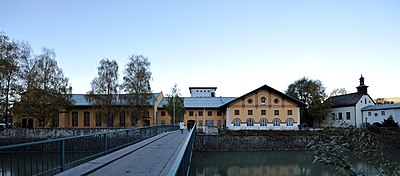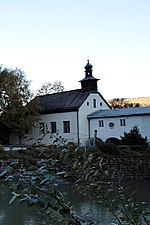Pernerinsel
The Pernerinsel is an island in the middle of the Salzach in the city of Hallein in the state of Salzburg . A salt works was built there from 1854 to 1862 and remained in operation until the 1980s. The listed saltworks building has been used as a venue by the Salzburg Festival since 1992 .
geography
The Pernerinsel is around 500 meters long and up to 200 meters wide. At the southern end is the Hallein city bridge and here the Pernerinsel divides the Salzach into two arms. At the northern end is the confluence of these two arms of the Salzach and the Almbach . Colloredobrücke, Heidebrücke, Pfannhausersteg and Kühbrücke connect the island with the surrounding districts. The Salzachtal Straße (B159) leads from the city bridge over the Mauttorpromenade to the Colloredo bridge.
Saltworks
The name Hallein is derived from an Old High German * hal (a) - , mhd. Hal 'Salzquelle, Salzwerk' and the diminutive "-lîn". And the salt gave both the city and the country its name. The Colloredo mansion in the old town of Hallein, first mentioned in a document under Archbishop Hieronymus Colloredo around 1798 , was planned as a brewhouse, but played no role in salt production, as the system turned out to be a technical faulty construction. Despite the renovation, it was not possible to remedy these deficiencies and in 1803 operations were stopped. The "Colloredo Sudhaus", however, was the forerunner of the salt works on the Pernerinsel, which was built between 1854 and 1862. Salt was processed in the large old industrial hall until 1989, after which all salt production in the state of Salzburg ended.
As a result of an initiative by cultural workers, the Sudhalle der Salinen was rededicated into a theater space, which was integrated into the Salzburg Festival program as a venue by the new theater director Peter Stein in 1992. The adaptation only took eighty days to build. The first production was the trilogy of antiquities by Andrei Serban based on Sophocles , Euripides and Seneca . In 1998 the seating and break room were renewed.
The hall is used in particular for contemporary drama productions, occasionally also singing games , operas , operettas or concerts , whereby the performance and audience area can be adapted to the needs of the respective production. The German-language premiere of Luk Perceval's battles achieved cult status ! (1999), a new version of Shakespeare's Wars of the Roses : it had a duration of twelve hours, of which nine hours were played. The critics of the trade journal Theater heute voted the production 2000 the best of the year.
The following additional festival productions attracted particular attention:
- 1997: Grillparzer's Libussa , staged by Peter Stein
- 2001: The Bat by Johann Strauss in a provocative reinterpretation by Hans Neuenfels
- 2010: “ Oedipus on Colonus ” by Sophocles with Klaus Maria Brandauer , directed by Peter Stein
- 2011: Goethe's Faust I + II , an eight-hour version directed by Nicolas Stemann in cooperation with the Thalia Theater (Hamburg)
- 2012: Henrik Ibsen’s Peer Gynt in an English-language version by the director Irina Brook and
- 2014: Ödön von Horváths Don Juan comes from the war , staged by Andreas Kriegenburg
The venue consists of a large room with variable seating for up to 800 visitors. The room layout of the performance and audience areas in the former brine cleaning hall can be structured according to the scenic concept of the respective director and set designer. The room acoustics are changed by variable wall cladding and ceiling reflectors in order to achieve optimal speech intelligibility. Depending on the needs of the respective production, the stage technology is installed and adjusted on a mobile basis, as is the lighting and the electroacoustics. The technical equipment corresponds to the standard of the Salzburg festival halls. A free bus shuttle brings festival guests , if they do not arrive with their own car, from Salzburg to the Pernerinsel in Hallein an hour before the performance begins.
The Pernerinsel is also used by the Salzburg scene for its own productions.
Care chapel for the Holy Spirit
The Care Chapel of the Holy Spirit, also known as the Saline Chapel, probably dates from the early 17th century. The former sacristan's house connects to the simple building in the south. The altar from the mid-18th century once stood in the abandoned St. Ursula Chapel. The figure of an enthroned Madonna and Child was created around 1450. The chapel is a listed building .
See also
literature
- Georg Clam Martinic : Castles and palaces in Austria. Landesverlag in Veritas Verlag, Linz 1991, ISBN 3-85214-559-7 .
Web links
- Salzburg Festival , brief description of the Pernerinsel (including seating plan)
Individual evidence
- ↑ Josef Wind: The Pernerinsel in the heart of the city. In: Stadt Magazin - information from the town hall of Hallein. 11th year. Episode 42nd July 2020
- ↑ Developed from ahd. Hal (a) salt 'Salt from the Salt Spring ' and halhûs ' Boiling House of the Salt Works, Saline'
- ↑ Georg Clam Martinic, 1991, p. 272.
- ↑ SIMs KULTUR: Perner-Insel, Hallein , accessed on May 5, 2016
- ↑ hallein.com: Alte Saline as a theater venue , accessed on May 5, 2016
- ↑ a b Norbert Mayer: Ready for the island and for large theater , Die Presse (Vienna), June 8, 2012, accessed on May 4, 2016
- ↑ ORF : “Renewer of the Festival” Mortier died , March 9, 2014, accessed on May 4, 2016
- ↑ Barbara Petsch: "Don Juan": Desperate Housewives im Feldpostregen , Die Presse (Vienna), August 18, 2014, accessed on May 4, 2016
Coordinates: 47 ° 41 ′ N , 13 ° 6 ′ E


